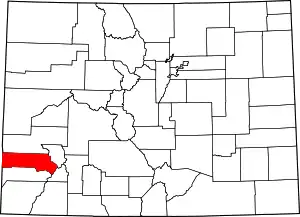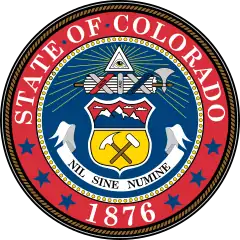San Miguel County, Colorado
San Miguel County is one of the 64 counties of the U.S. state of Colorado. As of the 2010 census, the population was 7,359.[1] The county seat is Telluride.[2] The county is named for the San Miguel River.
San Miguel County | |
|---|---|
 The San Miguel County Courthouse | |
 Location within the U.S. state of Colorado | |
 Colorado's location within the U.S. | |
| Coordinates: 38°01′N 108°26′W | |
| Country | |
| State | |
| Founded | March 2, 1883 |
| Named for | San Miguel River |
| Seat | Telluride |
| Largest town | Telluride |
| Area | |
| • Total | 1,289 sq mi (3,340 km2) |
| • Land | 1,287 sq mi (3,330 km2) |
| • Water | 2.0 sq mi (5 km2) 0.2%% |
| Population | |
| • Estimate (2019) | 8,179 |
| • Density | 5.7/sq mi (2.2/km2) |
| Time zone | UTC−7 (Mountain) |
| • Summer (DST) | UTC−6 (MDT) |
| Congressional district | 3rd |
| Website | www |
History
San Miguel County was given the Spanish language name for "Saint Michael" due to the nearby San Miguel River. On 27 February 1883, Ouray County was split to form San Miguel County. Originally the San Miguel County portion was to retain the name Ouray County with the new portion called Uncompahgre County.
Mining operators in the San Juan mountain area of Colorado formed the San Juan District Mining Association (SJDMA) in 1903, as a direct result of a Western Federation of Miners proposal to the Telluride Mining Association for the eight-hour day, which had been approved in a referendum by 72 percent of Colorado voters.[3] The new association consolidated the power of thirty-six mining properties in San Miguel, Ouray, and San Juan counties.[4] The SJDMA refused to consider any reduction in hours or increase in wages, helping to provoke a bitter strike.
In 1875, the Smuggler gold vein was discovered near Telluride. The Smuggler-Union, Tomboy, and Liberty Bell mines combined produced over a hundred tons of gold by 1920, third in the state of Colorado.[5]:51,83
Geography
According to the U.S. Census Bureau, the county has a total area of 1,289 square miles (3,340 km2), of which 1,287 square miles (3,330 km2) is land and 2.0 square miles (5.2 km2) (0.2%) is water.[6]
Adjacent counties
- Montrose County - north
- Ouray County - east
- San Juan County - southeast
- Dolores County - south
- San Juan County, Utah - west
Major highways
National protected areas
Trails and byways
- Great Parks Bicycle Route
- San Juan Skyway National Scenic Byway
- Unaweep/Tabeguache Scenic and Historic Byway
- Western Express Bicycle Route
Demographics
| Historical population | |||
|---|---|---|---|
| Census | Pop. | %± | |
| 1890 | 2,909 | — | |
| 1900 | 5,379 | 84.9% | |
| 1910 | 4,700 | −12.6% | |
| 1920 | 5,281 | 12.4% | |
| 1930 | 2,184 | −58.6% | |
| 1940 | 3,664 | 67.8% | |
| 1950 | 2,693 | −26.5% | |
| 1960 | 2,944 | 9.3% | |
| 1970 | 1,949 | −33.8% | |
| 1980 | 3,192 | 63.8% | |
| 1990 | 3,653 | 14.4% | |
| 2000 | 6,594 | 80.5% | |
| 2010 | 7,359 | 11.6% | |
| 2019 (est.) | 8,179 | [7] | 11.1% |
| U.S. Decennial Census[8] 1790-1960[9] 1900-1990[10] 1990-2000[11] 2010-2015[1] | |||
At the 2000 census there were 6,594 people, 3,015 households, and 1,423 families living in the county. The population density was 5 people per square mile (2/km2). There were 5,197 housing units at an average density of 4 per square mile (2/km2). The racial makeup of the county was 93.57% White, 0.29% Black or African American, 0.85% Native American, 0.74% Asian, 0.08% Pacific Islander, 3.37% from other races, and 1.11% from two or more races. 8.6% of the population were Hispanic or Latino of any race.[12] Of the 3,015 households 22.80% had children under the age of 18 living with them, 38.30% were married couples living together, 5.40% had a female householder with no husband present, and 52.80% were non-families. 32.70% of households were one person and 2.50% were one person aged 65 or older. The average household size was 2.18 and the average family size was 2.77.
The age distribution was 17.60% under the age of 18, 9.90% from 18 to 24, 43.30% from 25 to 44, 25.80% from 45 to 64, and 3.40% 65 or older. The median age was 34 years. For every 100 females there were 120.80 males. For every 100 females age eighteen 18 and over, there were 126.40 males.
The median household income was $48,514 and the median family income was $60,417. Males had a median income of $35,922 versus $30,278 for females. The per capita income for the county was $35,329. About 6.60% of families and 10.40% of the population were below the poverty line, including 11.10% of those under age 18 and 8.00% of those age 65 or over.
Politics
For most of the 20th century, San Miguel County was a national bellwether. It voted for the winner in every presidential election from 1912 to 1984. Since 1988, the county has become one of the most Democratic in Colorado and the nation, largely due to the presence of the Telluride Ski Resort and the influx of liberal-minded voters in the 1960s and 1970s. These trends have made San Miguel similar in vein to other heavily Democratic ski resort counties like Blaine County in Idaho, Teton County in Wyoming, and Pitkin County within Colorado. In the 2000 presidential election, San Miguel County was Green Party candidate Ralph Nader's best countywide performance in the country with 17.2% of the vote.
| Year | Republican | Democratic | Others |
|---|---|---|---|
| 2016 | 23.9% 1,033 | 68.7% 2,975 | 7.4% 321 |
| 2012 | 27.1% 1,154 | 70.3% 2,992 | 2.6% 110 |
| 2008 | 21.5% 933 | 77.0% 3,349 | 1.6% 68 |
| 2004 | 26.9% 1,079 | 71.6% 2,876 | 1.6% 64 |
| 2000 | 32.0% 1,043 | 49.1% 1,598 | 18.9% 614 |
| 1996 | 28.2% 773 | 56.0% 1,535 | 15.9% 435 |
| 1992 | 23.6% 628 | 51.8% 1,380 | 24.6% 655 |
| 1988 | 43.4% 798 | 52.3% 961 | 4.4% 80 |
| 1984 | 54.8% 833 | 43.0% 654 | 2.2% 34 |
| 1980 | 42.8% 774 | 36.0% 651 | 21.2% 384 |
| 1976 | 43.8% 622 | 47.5% 674 | 8.7% 123 |
| 1972 | 55.0% 583 | 40.2% 426 | 4.9% 52 |
| 1968 | 53.2% 422 | 39.2% 311 | 7.6% 60 |
| 1964 | 34.2% 332 | 65.6% 636 | 0.2% 2 |
| 1960 | 46.1% 525 | 53.7% 612 | 0.2% 2 |
| 1956 | 57.9% 648 | 41.9% 469 | 0.3% 3 |
| 1952 | 55.2% 654 | 44.2% 524 | 0.6% 7 |
| 1948 | 41.8% 451 | 56.8% 613 | 1.4% 15 |
| 1944 | 45.7% 536 | 53.7% 630 | 0.6% 7 |
| 1940 | 45.9% 729 | 53.6% 851 | 0.4% 7 |
| 1936 | 32.1% 433 | 63.8% 860 | 4.1% 55 |
| 1932 | 29.7% 383 | 66.9% 862 | 3.3% 43 |
| 1928 | 54.9% 721 | 42.2% 554 | 2.9% 38 |
| 1924 | 43.6% 677 | 36.5% 567 | 19.9% 308 |
| 1920 | 54.3% 928 | 40.3% 688 | 5.4% 93 |
| 1916 | 29.1% 578 | 66.8% 1,325 | 4.1% 81 |
| 1912 | 30.4% 639 | 48.9% 1,029 | 20.8% 437 |
Communities
See also
References
- "State & County QuickFacts". United States Census Bureau. Retrieved June 11, 2014.
- "Find a County". National Association of Counties. Retrieved 2011-06-07.
- Roughneck—The Life and Times of Big Bill Haywood, Peter Carlson, 1983, page 65.
- The Corpse On Boomerang Road, Telluride's War On Labor 1899-1908, MaryJoy Martin, 2004, page 201.
- Voynick, S.M., 1992, Colorado Gold, Missoula: Mountain Press Publishing Company, ISBN 0878424555
- "US Gazetteer files: 2010, 2000, and 1990". United States Census Bureau. 2011-02-12. Retrieved 2011-04-23.
- "Population and Housing Unit Estimates". Retrieved December 12, 2019.
- "U.S. Decennial Census". United States Census Bureau. Retrieved June 11, 2014.
- "Historical Census Browser". University of Virginia Library. Retrieved June 11, 2014.
- "Population of Counties by Decennial Census: 1900 to 1990". United States Census Bureau. Retrieved June 11, 2014.
- "Census 2000 PHC-T-4. Ranking Tables for Counties: 1990 and 2000" (PDF). United States Census Bureau. Retrieved June 11, 2014.
- "U.S. Census website". United States Census Bureau. Retrieved 2011-05-14.
- Leip, David. "Dave Leip's Atlas of U.S. Presidential Elections". uselectionatlas.org. Retrieved May 26, 2017.
